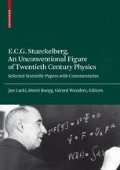Zusammenfassung
Inhalt: Elektron, Neutrino, Proton und Neutron werden als vier verschiedene Quantenzustände einer einzigen Elementpartikel angesehen. Quantensprünge zwischen diesen Zuständen erklären den β-Zerfall (gemäss der Theorie von Fermi) und geben zur HEISENBEBe-MAJOKANA’schen Neutron-Proton-Austauschkraft Anlass. Die Pestsetzung, dass negatives Elektron und positives Proton „Partikel“-Zustände (im Gegensatz zu „Antipartikel“) sind, verbietet Zerstrahlungsprozesse der schweren Teilchen. Die umgekehrte Festsetzung (positives Elektron und positives Proton sind Partikel) führt zu Zerstrahlungsprozessen (siehe Zusammenfassung).
Access this chapter
Tax calculation will be finalised at checkout
Purchases are for personal use only
Preview
Unable to display preview. Download preview PDF.
Literatur
G. Mie, Ann. d. Phys. 37, 512, 39, 1 und 40, 1 (1912–1913); H. Weyl, raum — Zeit — Materie 1920. A. Einstein und W. Mayer, Sitz. Ber. der Preuss. Akad. d. Wiss. 1931.
W. Pauli und V. Weisskopf, Helv. Physica Acta 7, 709 (1934).
W. Heisenberg, Zs. f. Phys. 90, 209 (1934).
B. L. van deb Warden, Gruppentheoret. Methode i. d. Quantenmechanik, Berlin 1932.
L. de Broglie, Une nouvelle conception de la lumière, Act. Scint. Hermann, Paris 1934.
G. Wentzel, Zs. f. Phys. 92, 337 (1934); P. Jordan, Zs. f. Phys. 93, 464 (1935), 98, 709 und 759 (1936), 99, 109 (1936); R. DE L. Kronjg, Physica 2, 491, 854, 968 (1935); O. Scherzee, Zs. f. Phys. 97, 725 (1935).
M. Born und L. Infeld, Proc. Eoy. Soc. A 144, 423 (1934) und folgende Arbeiten.
P. Jordan, loc. cit., Zs. f. Phys. 98, 761 u. ff. (1936).
E. Fermi, Zs. f. Phys. 88, 161 (1934).
E. Majoratta, Zs. f. Phys. 82, 137 (1933).
P. Jordan und E. Wignee, Zs. f. Phys. 47, 631 (1928), cf. auch W. Heisknberg, Physikalische Prinzipien der Quantenmechanik, Leipzig 1930.
Siehe z. B. Heisknberg, Zs. f. Phys. 47, 631 (1928)
E. J. Konopinski und G. E. Uhlenbeck, Phys. Rev. 48, 7 und 107 (1935).
Editor information
Editors and Affiliations
Rights and permissions
Copyright information
© 2009 Birkhäuser Verlag AG
About this chapter
Cite this chapter
(2009). Austauschskräfte zwischen Elementarteilchen und Fermische Theorie des β-Zerfalls als Konsquenzen einer möglichen Feldtheorie der Materie [26]. In: Lacki, J., Ruegg, H., Wanders, G. (eds) E.C.G. Stueckelberg, An Unconventional Figure of Twentieth Century Physics. Birkhäuser Basel. https://doi.org/10.1007/978-3-7643-8878-2_11
Download citation
DOI: https://doi.org/10.1007/978-3-7643-8878-2_11
Publisher Name: Birkhäuser Basel
Print ISBN: 978-3-7643-8877-5
Online ISBN: 978-3-7643-8878-2
eBook Packages: Physics and AstronomyPhysics and Astronomy (R0)

